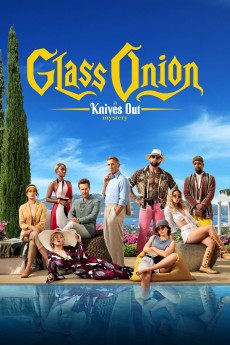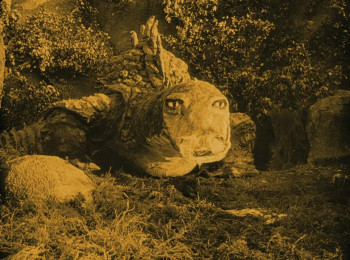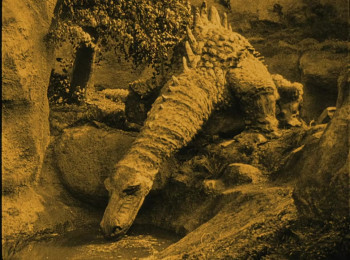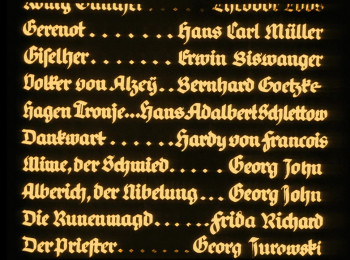UFA's Die Nibelungen films have suffered from a problem common to Metropolis, King Kong and Snow White and the Seven Dwarfs, in that they are motion picture classics that also happen to have been favourites with Adolf Hitler. While those others I mentioned tend to be overlooked as coincidences evidence of nothing more than that sometimes even fascist dictators have taste the Nibelungen pictures have fared a little worse because of the significance of the legend to German nationalism, as typified in the opera by the German anti-Semite Wagner.
However, while the Nazis may have been able to project their racial ideology onto the original story, Fritz Lang's direction of the motion picture version actually breaks with the heroic nationalist reinterpretation. Wagner's opera was calculated to be exciting and rousing. Screenwriter Thea von Harbou would eventually become a nazi stooge, and probably intended a similar effect for the film. The original poem Nibelungenlied though is not intrinsically nationalistic it is simply a folk tale in a similar vein the King Arthur legend or the Iliad, and Lang recognised this fact. Like those ancient sagas from which it is drawn, his version is lacking in any kind of emotional manipulation, yet is rich in pageantry and poetic imagery. In Die Nibelungen we in fact have a perfect example of how a director's formal technique can shape the tone of a film.
Throughout the picture, Lang takes a cool, detached approach to the material. There are few close-ups or point-of-view shots. We know that Lang was not averse to these techniques look at his previous picture, Dr Mabuse, where the title character is often staring straight into the lens, as if to hypnotise the audience. Let's also compare the dragon slaying scenes from Die Nibelungen and the Douglas Fairbanks Thief of Bagdad (directed by Raoul Walsh). The important difference here is not who had the best dragon (and to be fair they are both pretty naff), but how they are filmed. For the Fairbanks legend to work, you have to get swept up in the action, and Walsh places the camera at the hero's back as he delivers the fatal blow, bringing the audience in for the kill too. Siegfried's fight is staged almost identically yet Lang just matter-of-factly shows it happen, even giving us the dragon's death indirectly with a shot of its tail flopping to the ground.
All this is not to say that Lang did not have respect for the Nibelungen story. He had great reverence for it, but again purely in the form of an old legend an artefact of a bygone era, not something that a modern audience can or should try to relate to, but something profound and beautiful nonetheless. Lang reflects this in the overall look of the picture, forming neat, painterly tableau, encouraging exaggerated, theatrical acting and giving the overall picture a stylised sense of rhythm. Ironically he brings it close to opera in tone, although of course this version was in no other way like Wagner's.
Lang's distinctive visual style pervades Die Nibelungen. So far, Lang had made striking use of interiors, but Siegfried's story mostly takes place outdoors. There are no rolling vistas here though. Lang creates a claustrophobic landscape out of crowding forests and overbearing rock formations. In earlier Lang films we can already see how his sets and shot compositions seem to form patterns and paths to hem in the characters and even control their movements, but now the actors almost seem to become part of the scenery. Take for example a shot about two-thirds of the way through, when Brunhild is framed between two curtains the pattern on her dress matches that on the curtains. Throughout his career Lang first and foremost shoots the sets the actors are merely a part of them.
This thoroughly Langian interpretation of the Nibelungenlied may have brought a tear to the eye of Hitler and Goebbels, but the emotional connection to the material can only have existed in their heads. To the majority of viewers, this picture and its sequel do not encourage any kind of romantic or heroic feeling. They are in a way more of an illustration than a story in their own right. While this detached style does not make for gripping viewing, the films do have an aesthetic beauty to them that makes them watchable.
Die Nibelungen: Siegfried
1924 [GERMAN]
Action / Adventure / Drama / Fantasy
Plot summary
Siegfried, son of King Siegmund of Xanten, travels to Worms, capital of the Burgundian kingdom, to ask King Gunther for the hand of his sister, the beautiful Kriemhild.
Uploaded by: FREEMAN
January 21, 2020 at 10:32 AM
Director
Top cast
Movie Reviews
"Your babbling, hero, is worse than murder"
The Fantastical One
I think this is an important film to see even for historical reasons, since after "Die Nibelungen" (1924) Lang would make "Metropolis" (1927), something for which he is best remembered. But more importantly, this is in my mind astonishingly gripping and the far more satisfying film (or two).
It's fascinating how different the two parts are. As they are, their respective brilliance shines brightly, individually, and in itself the film as one grand epic reinvents itself come the revenge story of the latter half. The first film is the fantastical one, precursor to what we have now as high fantasy adaptations, mainly "The Lord of the Rings". In this sense "Siegfried" is shockingly modern, and here Lang succeeds far better than in "Metropolis", where he didn't have a national epic upon which to project the visual aesthetics, instead his own sense of national identity projected into a perceived future or alternate present. This is surprisingly lucid, which itself is a testimony of its filmic brilliance.
The court at Worms is as rigidly symmetrical and foreboding as one can be, and the film is full of such visual information, rigid symmetry that I bet greatly inspired Eisentein's "Ivan Groznyi" films (1944, 1958). In fact, I would love to see these masterworks by the two directors together someday, since their similarities go beyond style and visual language, also converging in their handling of national folklore in highly theatrical terms.
The new restoration of the project, made by the Friedrich-Wilhelm-Murnau-Stiftung, is available on Blu-ray in both Region A and B, courtesy of Kino and Masters of Cinema respectively. What a treasure! In fact, the more I think of it, I can't wait to revisit it again.











